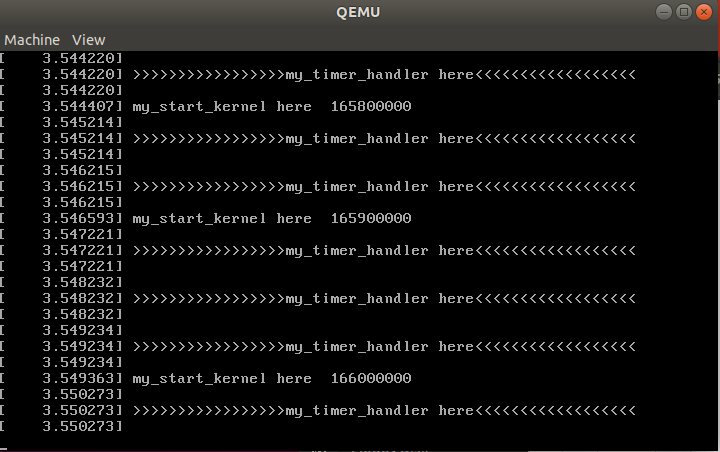前言
本文将参考相关文献https://mp.weixin.qq.com/s/SzpN1BNty5aPDZhNdCO5yA实现一个简易的linux操作系统内核,深入理解操作系统内核的基本工作原理,其源代码来自https://github.com/mengning/mykernel。
学过linux操作系统都知道系统启动后,内核入口是init/main.c中的start_kernel(void)函数、进程切换的代码是schedule(void)函数、进程控制块由struct tast_struct结构体定义。那么这里主要对这三个函数进行替换,对应自己的函数为my_start_kernel(void)、my_schedule(void)、struct PCB。
一、安装环境
wget https://raw.github.com/mengning/mykernel/master/mykernel-2.0_for_linux-5.4.34.patch sudo apt install axel axel -n 20 https://mirrors.edge.kernel.org/pub/linux/kernel/v5.x/linux-5.4.34.tar.xz xz -d linux-5.4.34.tar.xz tar -xvf linux-5.4.34.tar cd linux-5.4.34 patch -p1 < ../mykernel-2.0_for_linux-5.4.34.patch sudo apt install build-essential libncurses-dev bison flex libssl-dev libelf-dev make defconfig # Default configuration is based on 'x86_64_defconfig' make -j$(nproc) sudo apt install qemu # install QEMU
如果全部顺利执行,接下来可以执行以下代码直接运行模拟器,运行结果如下:
qemu-system-x86_64 -kernel arch/x86/boot/bzImage

二、struct PCB分析
进程控制块struct PCB在mypcb.h中定义,因为暂时只用了时间片轮转调度,因此PCB结构没有优先级,只具备最基本的成员。
/* CPU-specific state of this task */ struct Thread { unsigned long ip; // 进程ip unsigned long sp; // 栈顶指针sp }; typedef struct PCB{ int pid; /* 进程号 */ volatile long state; /* -1 unrunnable, 0 runnable, >0 stopped */ unsigned long stack[KERNEL_STACK_SIZE]; /* 进程堆栈 */ /* CPU-specific state of this task */ struct Thread thread; unsigned long task_entry; /* 进程代码入口 */ struct PCB *next; /* 指向下一个PCB */ }tPCB;
三、my_start_kernel(void)分析
my_start_kernel函数在mymain.c文件中定义,my_process函数是进程实体。my_start_kernel函数首先创建几个进程,然后运行0号进程,这部分由内嵌汇编代码实现,具体见注释。
void __init my_start_kernel(void) { int pid = 0; int i; /* Initialize process 0*/ task[pid].pid = pid; task[pid].state = 0;/* -1 unrunnable, 0 runnable, >0 stopped */ task[pid].task_entry = task[pid].thread.ip = (unsigned long)my_process; task[pid].thread.sp = (unsigned long)&task[pid].stack[KERNEL_STACK_SIZE-1]; task[pid].next = &task[pid]; /*fork more process */ for(i=1;i<MAX_TASK_NUM;i++) { memcpy(&task[i],&task[0],sizeof(tPCB)); task[i].pid = i; task[i].thread.sp = (unsigned long)(&task[i].stack[KERNEL_STACK_SIZE-1]); task[i].next = task[i-1].next; task[i-1].next = &task[i]; } /* start process 0 by task[0] */ pid = 0; my_current_task = &task[pid]; asm volatile( "movq %1,%%rsp " /* 将RSP寄存器指向进程0的堆栈栈底,task[pid].thread.sp初始值即为进程0的堆栈栈底 */ "pushq %1 " /* push rbp,将当前RBP寄存器值压栈 */ "pushq %0 " /* push task[pid].thread.ip,将当前进程的RIP(这里是初始化的值my_process(void)函数的位置)压栈 */ "ret " /* ret 将栈顶位置的task[0].thread.ip,也就是my_process(void)函数的地址放入RIP寄存器中,相应的RSP寄存器指向的位置也发生了变化 */ : : "c" (task[pid].thread.ip),"d" (task[pid].thread.sp) /* input c or d mean %ecx/%edx*/ ); } int i = 0; void my_process(void) { while(1) { i++; if(i%10000000 == 0) { printk(KERN_NOTICE "this is process %d - ",my_current_task->pid); if(my_need_sched == 1) { my_need_sched = 0; my_schedule(); /* 执行调度 */ } printk(KERN_NOTICE "this is process %d + ",my_current_task->pid); } } }
四、my_schedule(void)分析
进程函数中每隔一定时间会执行一次调度,调度的代码在my_schedule(void)函数中实现,首先找到PCB链表中的下一个节点,然后切换到该进程,这部分代码由内嵌汇编实现。
void my_schedule(void) { tPCB * next; tPCB * prev; if(my_current_task == NULL || my_current_task->next == NULL) { return; } printk(KERN_NOTICE ">>>my_schedule<<< "); /* schedule */ next = my_current_task->next; /* 下一个PCB */ prev = my_current_task; /* 当前PCB */ if(next->state == 0)/* -1 unrunnable, 0 runnable, >0 stopped */ { my_current_task = next; printk(KERN_NOTICE ">>>switch %d to %d<<< ",prev->pid,next->pid); /* switch to next process */ asm volatile( "pushq %%rbp " /* save rbp of prev */ "movq %%rsp,%0 " /* save rsp of prev */ "movq %2,%%rsp " /* restore rsp of next */ "movq $1f,%1 " /* save rip of prev */ "pushq %3 " "ret " /* restore rip of next */ "1: " /* next process start here */ "popq %%rbp " : "=m" (prev->thread.sp),"=m" (prev->thread.ip) : "m" (next->thread.sp),"m" (next->thread.ip) ); } return; }
进程切换过程中prev进程和next进程的堆栈和相关寄存器的变化过程大致如下:
1. pushq %%rbp 保存prev进程的当前RBP寄存器的值到prev进程的堆栈。
2. movq %%rsp,%0 保存prev进程的当前RSP寄存器的值到prev->thread.sp,实际上就是将prev进程的栈顶地址保存。
3. movq %2,%%rsp 将next进程的栈顶地址next->thread.sp放入RSP寄存器,完成了prev进程和next进程的堆栈切换。
4. movq $1f,%1 保存prev进程当前RIP寄存器值到prev->thread.ip,这里$1f是指标号1。
5. pushq %3 把即将执行的next进程的指令地址next->thread.ip入栈,这时的next->thread.ip可能是next进程的起点my_process(void)函数,也可能是$1f(标号1)。第一次被执行从头开始为next进程的起点my_process(void)函数,其余的情况均为$1f(标号1),因为next进程如果之前运行过那么它就一定曾经也作为prev进程被进程切换过。
6. ret 就是将压入栈中的next->thread.ip放入RIP寄存器,为什么不直接放入RIP寄存器呢?因为程序不能直接使用RIP寄存器,只能通过call、ret等指令间接改变RIP寄存器。
7. 标号1是一个特殊的地址位置,该位置的地址是$1f。
8. popq %%rbp 将next进程堆栈基地址从堆栈中恢复到RBP寄存器中。
五、实验结果
将以上代码代码添加到mykernel文件夹下,并重新编译内核,再运行查看结果如下:
